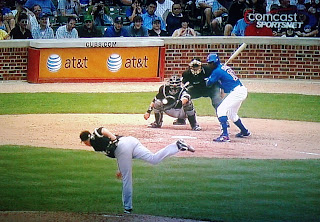Stealing signs – Part 2: How to know if your signs are being stolen.
October 19, 2011 by Coach McCreary
Filed under Coaching
In the major leagues, every time a team gets caught or is even suspected of stealing signs from a catcher, there is always debate as to the ethics and morality of doing so. For these posts, I will avoid the pros and cons of the controversy and simply stick to the ways teams typically get them and give them (Part 1) and use that information to determine if your signs are being stolen (Part 2) and how to prevent a team from doing it (Part 3).
If you know what you are looking for and when to look for them, detecting sign stealing is not all that difficult. Usually the teams that are best at stealing signs are also very good at detecting when opponents are doing the same. The “it takes a thief to catch a thief” principle usually applies well here. It’s important to first understand that the whole process of getting the sign and passing it to the batter occurs within a tiny window of time (about a second or two) immediately following the catcher’s sign to the pitcher. As a result, paying close attention to what goes on during that small window is key. Here are three things to pay attention to:
 |
| Intense focus on this guy while giving signs is something to watch out for. |
Look for focused attention on the catcher. When a pitcher is on the mound with the ball and getting the sign, all eyes are usually on him. When coaches, bench players, and/or base runners are focused intently on the catcher, that’s a red flag that somebody might be up to no good. They may not be but it’s worth keeping an eye on.
 |
| “Confident takes” in unusual situations is a big red flag |
Watch the batter’s swings and “takes.” When a batter knows what’s coming, he usually increases his aggressiveness at the plate even in counts where a normal batter would be more defensive. A batter with two strikes normally shortens up their swing and becomes more defensive so as not to strike out. This isn’t as necessary if you know what’s coming. Very aggressive swings in defensive counts might be a red flag. Also pay close attention to hitters who seem to be right on pitches that would normally give hitters trouble. A 2-0 curve ball would be an example. Every hitter on earth sits fastball on that count. A hitter who swings at a breaking pitch in that count as if they know what’s coming may have, in fact, known what was coming. Watching how a batter takes a pitch can raise some suspicion as well. Some pitchers get a lot of batters to either swing at pitches in the dirt or at least cause them to check their swings on most takes. This is usually caused by the pitcher having a late breaking curve ball or slider that suddenly breaks out of the strike zone in the last few feet of the pitch. It could also be a great change-up that consistently gets batters out on their front foot even if they take the pitch. These are usually your strike out pitchers. If batters don’t even flinch at such pitches and have what is called “confident takes,” something might be going on. A coach might say, “Boy, these opposing hitters are really disciplined today.” A more suspicious coach might ask “How in the world did that guy take that 1-2 pitch?” Repeated “confident takes” in certain situations are a huge red flag.
If you pay attention to the right people at the right time, you will increase your chances of catching the thief. When that occurs, you now can do something about it. That’s Part 3!





Leave a Reply